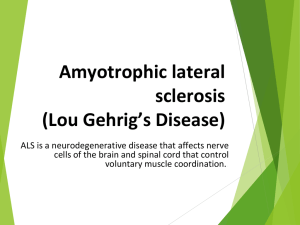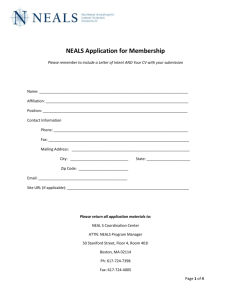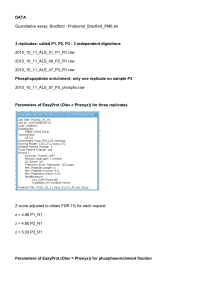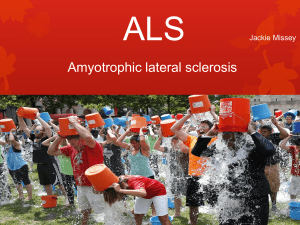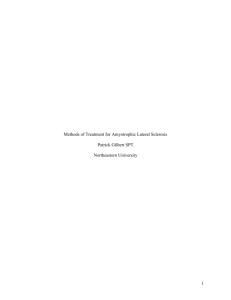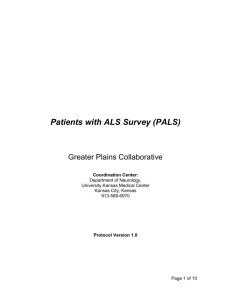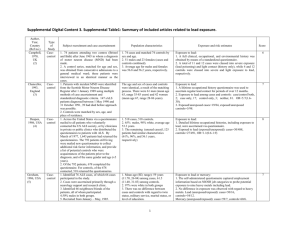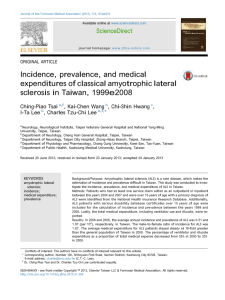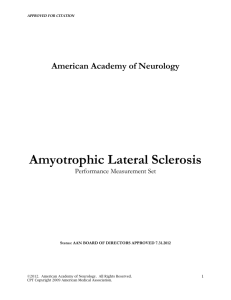Elizabeth Buckwalter Amyotrophic Lateral Sclerosis and Physical
advertisement
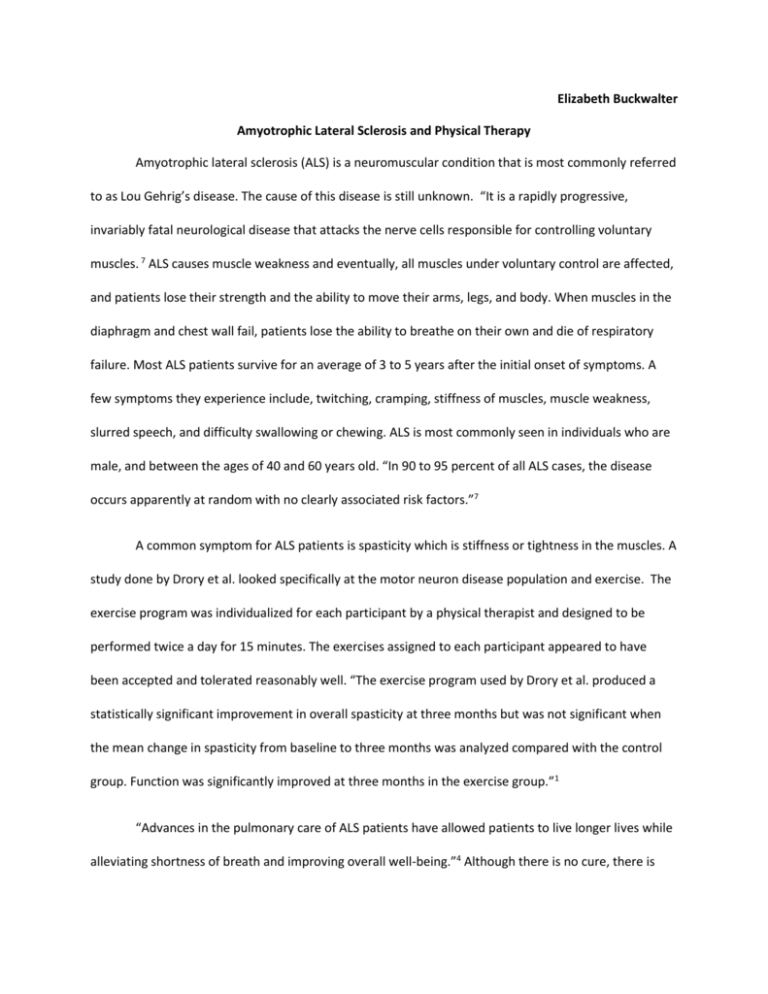
Elizabeth Buckwalter Amyotrophic Lateral Sclerosis and Physical Therapy Amyotrophic lateral sclerosis (ALS) is a neuromuscular condition that is most commonly referred to as Lou Gehrig’s disease. The cause of this disease is still unknown. “It is a rapidly progressive, invariably fatal neurological disease that attacks the nerve cells responsible for controlling voluntary muscles. 7 ALS causes muscle weakness and eventually, all muscles under voluntary control are affected, and patients lose their strength and the ability to move their arms, legs, and body. When muscles in the diaphragm and chest wall fail, patients lose the ability to breathe on their own and die of respiratory failure. Most ALS patients survive for an average of 3 to 5 years after the initial onset of symptoms. A few symptoms they experience include, twitching, cramping, stiffness of muscles, muscle weakness, slurred speech, and difficulty swallowing or chewing. ALS is most commonly seen in individuals who are male, and between the ages of 40 and 60 years old. “In 90 to 95 percent of all ALS cases, the disease occurs apparently at random with no clearly associated risk factors.”7 A common symptom for ALS patients is spasticity which is stiffness or tightness in the muscles. A study done by Drory et al. looked specifically at the motor neuron disease population and exercise. The exercise program was individualized for each participant by a physical therapist and designed to be performed twice a day for 15 minutes. The exercises assigned to each participant appeared to have been accepted and tolerated reasonably well. “The exercise program used by Drory et al. produced a statistically significant improvement in overall spasticity at three months but was not significant when the mean change in spasticity from baseline to three months was analyzed compared with the control group. Function was significantly improved at three months in the exercise group.”1 “Advances in the pulmonary care of ALS patients have allowed patients to live longer lives while alleviating shortness of breath and improving overall well-being.”4 Although there is no cure, there is research that may find a cure in the future. Until a cure is found for ALS, respiratory care providers have a crucial role in evaluating, educating, and treating patients. Respiratory interventions have a greater impact on survival and quality of life than any other ALS treatments examined this far.4 Although this is not the job of a physical therapist, it is important to understand the best techniques used by ALS patients so they can stay strong and functional enough to perform physical tasks. Research is being done to find a cure and the FDA has approved a drug that has shown to add a few more months onto the lifespan of ALS patients. “The drug riluzole is believed to reduce damage to motor neurons by decreasing the release of glutamate.”7 There are other treatments available that are designed to relieve symptoms and to improve the patient’s quality of life. Some of these include speech therapists, nutritionists, social workers, home care nurses and physical therapists.7 “The role of the therapist is to provide preventive and supportive care for the secondary problems of weakness, recommend appropriate devices and equipment to keep the patient as independent as possible, and educate the family and caregivers regarding handling of the patient.” 6 “As ALS patients become more fragile, the responsibility and involvement of the physical therapist increases. Early discussion of aids, such as sticks, frames and wheelchairs, is helpful so that the person and their family can adjust to these new losses of independence.”2 “The use of assistive devices is a common intervention used to meet the goal of maintaining independence. Physical therapy should be involved in prescribing ambulatory aides. The therapist is able to individually address each patient’s needs based on their upper and lower extremity strength, amount of spasticity, gait pattern, and energy requirements.”5 It was found that a rolling walker should be used instead of a standard walker in the ALS population because the rolling walker requires less energy to use when compared to a standard walker. Energy expenditure increases with easier tasks for ALS patients as their symptoms worsen. When an ALS patient requires assistance in being moved from one location to another, there are different methods the physical therapist can use to transfer the patient safely and efficiently. A gait belt can be used, which provides a safe and easy way to provide assistance to the patient without putting harmful stress on the physical therapists body while maintaining control of the patient. Mechanical lifts can be used to transport the patient when the patient is completely dependent on another individual. Wheelchairs are an important piece of equipment used to help conserve the patient’s energy. Often, power wheelchairs are used because it allows the patient to keep their independence and does not require as much work for the ALS patient.5 Although exercise is normally beneficial, you do not want to overwork their muscles to exhaustion because this will only harm or discourage the patient. Based on the findings from the study done by Chen, Montes, and Mitsumoto it was concluded that exercise is likely to be more beneficial than harmful for patients who have ALS. They recommend individualized and carefully monitored, progressive resistance exercise in patients who have early ALS, for functional improvement. The findings were not significant, so more studies are needed to examine the effects of strength and endurance training on ALS patients.3 Unfortunately ALS does not have a cure and although there has been research done on ALS and exercise, it is still controversial as to whether or not it is beneficial. More research and studies should be done in order to gain a better understanding of the effects of exercise on ALS patients. The physical therapist has the important role of deciding what the individual patient can and cannot handle. Physical therapists need to be careful not to overwork the muscles of the weak ALS patient because they may cause harm instead of benefits. Reference List 1. Ashworth NL, Satkunam LE, Deforge D. Treatment for spasticity in amyotrophic lateral sclerosis/motor neuron disease. Cochrane Database of Systematic Reviews 2012, Issue 2. Art. No.: CD004156. DOI: 10.1002/14651858.CD004156.pub4. 2. Brown RH; Swash M; Pasinelli, P. Amyotrophic Lateral Sclerosis. 2nd ed. Abingdon [England], Boca Raton, FL. Informa Healthcare. 2006 3. Chen A, Montes J, Mitsumoto H. The role of exercise in amyotrophic lateral sclerosis. Physical Medicine & Rehabilitation Clinics of North America [serial online]. August 2008;19(3):545-557. Available from: Pubmed, Ipswich, MA. 4. Lechtzin N. Respiratory effects of amyotrophic lateral sclerosis: problems and solutions. Respiratory Care [serial online]. August 2006;51(8):871-884. Available from: CINAHL, Ipswich, MA. 5. Lewis M, Rushanan S. The role of physical therapy and occupational therapy in the treatment of Amyotrophic Lateral Sclerosis. Neurorehabilitation [serial online]. December 2007;22(6):451-461. 6. Pagliarulo MA. Introduction to Physical Therapy. 4th Edition. St. Louis, Mo. Elsevier/Mosby. 2012. 7. Sutton AL. Movement Disorders Sourcebook. 2nd ed. Detroit, MI. Omnigraphics. 2009



